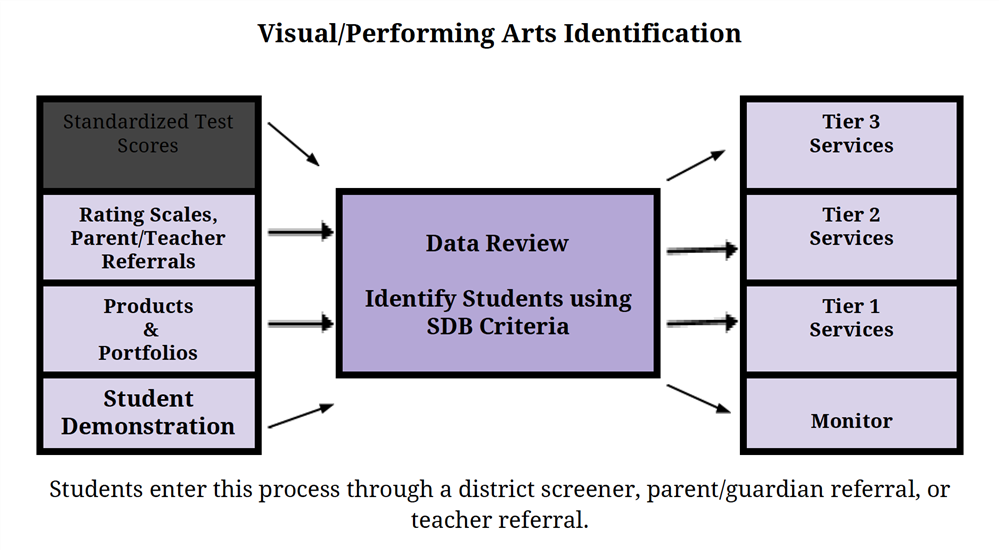- School District of Beloit
- Areas of Identification
Areas of Identification
-

Academic Ability
Academically capable students make outstanding progress in one or more of the disciplines. They acquire basic skill knowledge quickly, have high academic success in a special interest area, and demonstrate advanced memorization and comprehension abilities.
Specific Academic Ability - Criteria Guidelines
Tier I
Performance Evidence
• Student products, portfolios, performances
Assessment Data
• Consistent MAP scores at the 95th-96th percentile
• Consistent Smarter Balance scores at the 95th-96th percentile
• Additional nationally normed standardized test scores at 99th percentile (i.e. EXPLORE, PLAN, WJ-III, etc.)
• Appropriate rating scale score on the Scales for Rating the Behavioral Characteristics of Superior Students
• Consistent advanced performance on district formative and summative assessments
Tier II
Performance Evidence
• Student products, portfolios, performances
Assessment Data
• Consistent MAP scores at the 97th-98th percentile
• Consistent Smarter Balance scores at the 97th-98th percentile
• Additional nationally normed standardized test scores at 97th-98th percentile (i.e. EXPLORE, PLAN, WJ-III, etc.)
• Appropriate rating scale score on the Scales for Rating the Behavioral Characteristics of Superior Students
• Consistent advanced performance on district formative and summative assessments
Tier III
Performance Evidence
• Student products, portfolios, performances
Assessment Data
• Consistent MAP scores at the 99th percentiles
• Consistent Smarter Balance scores at the 99th percentile
• Additional nationally normed standardized test scores at 99th percentile (i.e. EXPLORE, PLAN, WJ-III, etc.)
• Appropriate rating scale score on the Scales for Rating the Behavioral Characteristics of Superior Students
• Consistent advanced performance on district formative and summative assessments
Specific Academic Characteristics
- Manipulates information
- Strong memorization ability
- Intense interest in a specific academic area
- High academic capacity in special interest area
- Pursues special interests with enthusiasm
- Operates at a higher level of abstraction than peers
- Asks poignant questions
*Adapted from the National Association for Gifted Children
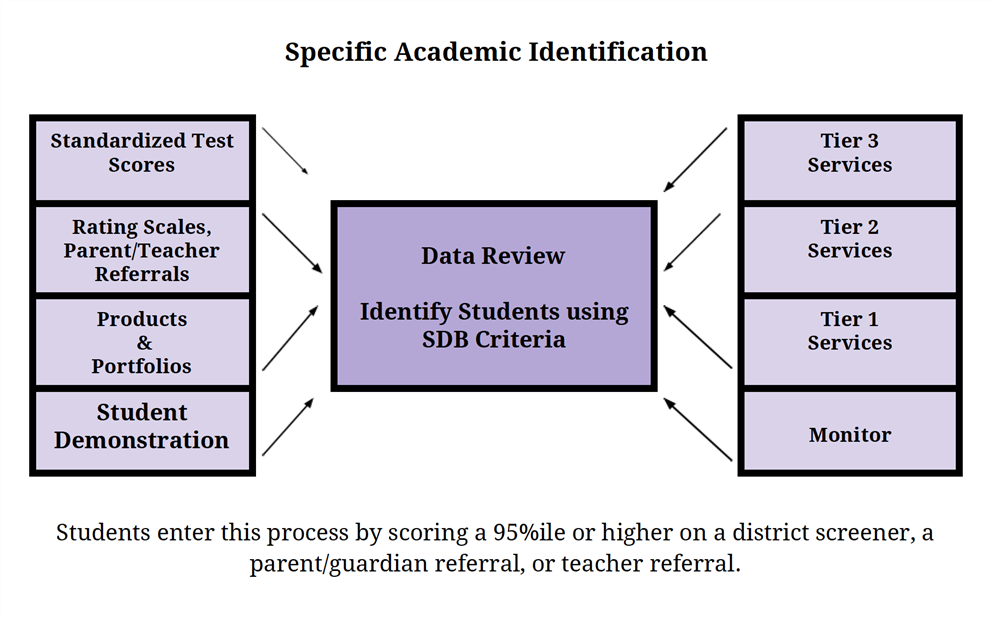
-

Creativity
Creative thinking crosses all areas: academics, arts, leadership, and intellect. Creative thinkers are independent thinkers, exhibit original thinking in oral and written expression, thinks of several solutions to a given problem, possess a sense of humor, create and invent, and are challenged by creative tasks.
Creativity - Criteria Guidelines
Tier I
Performance Evidence
• Student products, portfolios, performances
• Student-generated evidence (i.e. creative thinking activity, project, etc.)
Assessment Data
• A score of the 95th-96th percentile on the figural sections of the Torrance Test of Creative Thinking Supporting Data
• Appropriate rating scale score on the Scales for rating the Behavioral Characteristics of Superior Students
• Letter(s) of recommendation from a third party
Tier II
Performance Evidence
• Student products, portfolios, performances
• Student-generated evidence (i.e. creative thinking activity, project, etc.) Assessment Data
• A score of the 97th-98th percentile on the figural sections of the Torrance Test of Creative Thinking Supporting Data
• Appropriate rating scale score on the Scales for rating the Behavioral Characteristics of Superior Students
• Letter(s) of recommendation from a third party
Tier III
Performance Evidence
• Student products, portfolios, performances
• Student-generated evidence (i.e. creative thinking activity, project, etc.)
Assessment Data
• A score of the 99th percentile on the figural sections of the Torrance Test of Creative Thinking Supporting Data
• Appropriate rating scale score on the Scales for rating the Behavioral Characteristics of Superior Students
• Letter(s) of recommendation from a third party
Creativity Characteristics
- Discusses and elaborates in detail
- Exhibits original thinking in oral and/or written expression
- Generates many ideas to solve a given problem
- Possesses a keen sense of humor
- Creates and invents
- Intrigued by creative tasks
- Improvises and sees unique possibilities
- Risk-taker
- Resists conformity
*Adapted from the National Association for Gifted Children
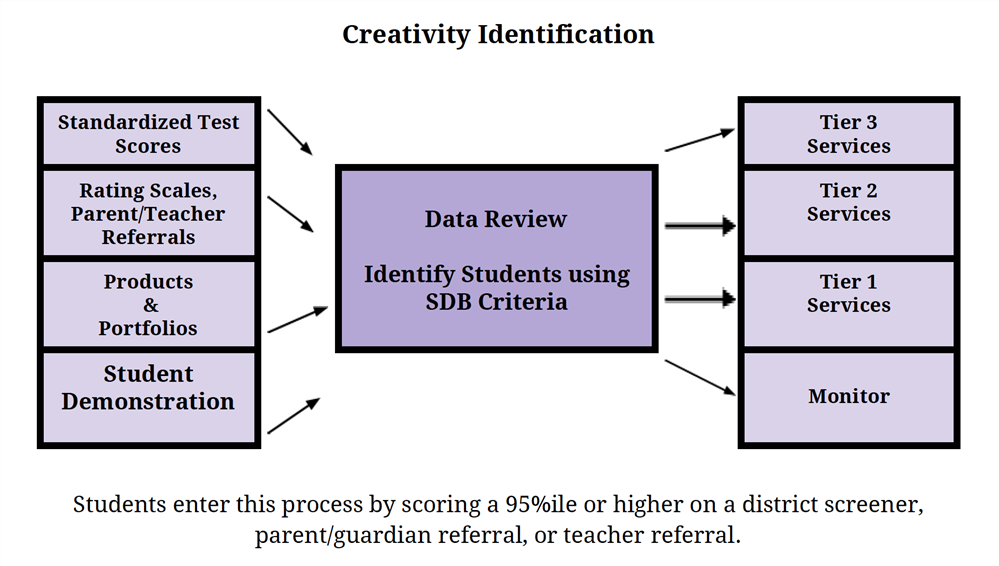
-

General Intellect
Intellectually gifted children learn rapidly, exhibit strong powers of reasoning, and develop an advanced ability in critical thinking and problem solving. They process information in complex ways, incorporate larger vocabulary in discussion, are inquisitive, and are self-starters.
General Intellectual Criteria Guidelines
Tier I
Performance Evidence
• Student products, portfolios, performances
• A score of 130-134 on appropriate aptitude test (i.e. CoGat, Naglieri Nonverbal Ability 2, Wechsler Intelligence Scale for Children, etc.)
Supporting Data
• Additional nationally normed standardized test scores at 95th-96th percentile and below (i.e. EXPLORE, PLAN, WJ-III, etc.)
• Appropriate rating scale score on the Scales for Rating the Behavioral Characteristics of Superior Students
• Consistent MAP scores at the 95th-96th percentile
• Consistent Smarter Balance scores at the 95th-96th percentile
Tier II
Performance Evidence
• Student products, portfolios, performances
• A score of 135-144 on appropriate aptitude test (i.e. CoGat, Naglieri Nonverbal Ability 2, Wechsler Intelligence Scale for Children, etc.)
Supporting Data
• Additional nationally normed standardized test scores at 97th-98th percentile (i.e. EXPLORE, PLAN, WJ-III, etc.)
• Appropriate rating scale score on the Scales for Rating the Behavioral Characteristics of Superior Students
• Consistent MAP scores at the 97th-98th percentiles
• Consistent Smarter Balance scores at the 97th-98th percentiles
Tier III
Performance Evidence
• Student products, portfolios, performances
• A score of 145 or higher on appropriate aptitude test (i.e. CoGat, Naglieri Nonverbal Ability 2, Wechsler Intelligence Scale for Children, etc.)
Supporting Data
• Additional nationally normed standardized test scores at 99th percentile (i.e. EXPLORE, PLAN, WJ-III, etc.)
• Appropriate rating scale score on the Scales for Rating the Behavioral Characteristics of Superior Students
• Consistent MAP scores at the 99th percentile
• Consistent Smarter Balance scores at the 99th percentile
General Intellectual Characteristics
- Understands complex concepts
- Draws inferences between content areas
- Sees beyond the obvious
- Thrives on new or complex ideas
- Enjoys hypothesizing
- Intuitively knows before taught
- Uses an extensive vocabulary
- Does in-depth investigations
- Learns rapidly in comparison to peers (12 repetitions for mastery)
*Adapted from the National Association for Gifted Children
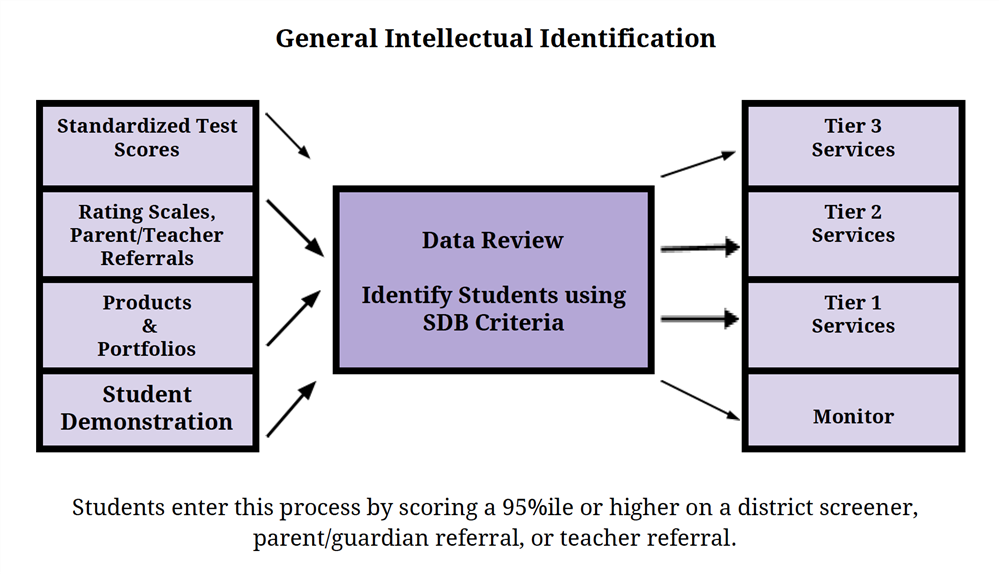
-

Leadership
Students gifted in leadership assume responsibility, are self-confident, have high expectations of self and others, and demonstrate good judgment in decision-making. Gifted leaders express themselves well, recognize leadership qualities in themselves and others and foresee consequences and implications of decisions.
Leadership - Criteria Guidelines
Tier I
Performance Evidence
• Student products, performance, portfolios (including a journal of activities: i.e. school newspaper, Student Council, school leadership
clubs, community-based projects, etc)
Supporting Data
• Appropriate rating scale score of 95th-96th percentile on the Scales for rating the Behavioral Characteristics of Superior Students
• Student-generated evidence of leadership activity
• Letter(s) of recommendation from a third party
Tier II
Performance Evidence
• Student products, performance, portfolios (including a journal of activities: i.e. school newspaper, Student Council, school leadership
clubs, community-based projects, etc)
Supporting Data
• Appropriate rating scale score of 97th-98th percentile on the Scales for rating the Behavioral Characteristics of Superior Students
• Student-generated evidence of leadership activity
• Letter(s) of recommendation from a third party
Tier III
Performance Evidence
• Student products, performance, portfolios (including a journal of activities: i.e. school newspaper, Student Council, school leadership
clubs, community-based projects, etc)
Supporting Data
• Appropriate rating scale score of 99th percentile on the Scales for rating the Behavioral Characteristics of Superior Students
• Student-generated evidence of leadership activity
• Letter(s) of recommendation from a third party
Leadership Characteristics
- Takes an active role in decision making
- High expectations for self and others
- Expresses self with confidence
- Foresees consequences and implications of decisions
- Follows through on a plan
- Appears to be well liked by peers
- Ideas expressed accepted by others
- Sought out by others to accomplish a task
*Adapted from the National Association for Gifted Children
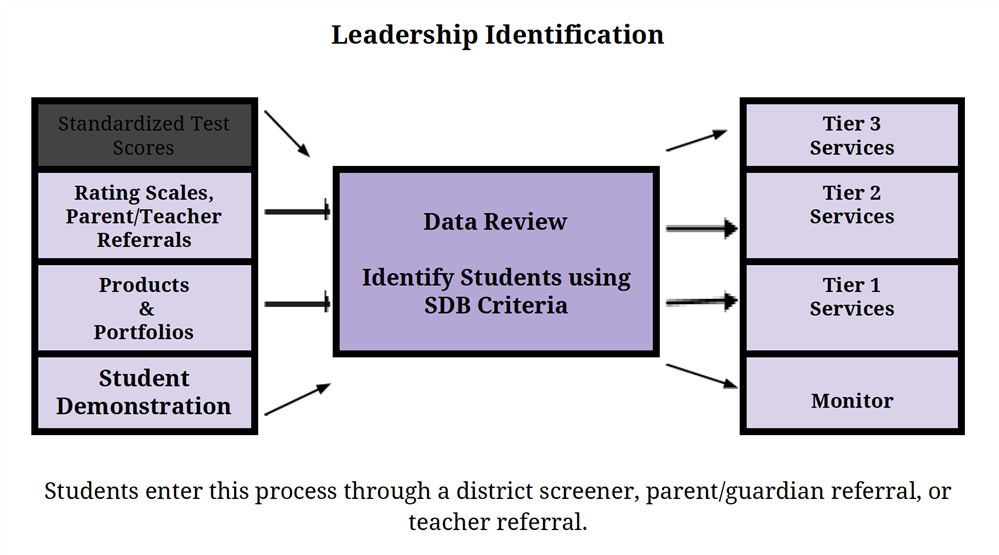
-

Visual and Performing Arts
Students exhibit outstanding ability in expressing self, feeling, moods, etc., through art, dance, drama, and music. Students demonstrate a keen sense of
spatial relationships and a strong sense of creative expression.Visual and Performing Arts - Criteria Guidelines
Tier I
Performance Evidence
• For ART - portfolio of work collected within one year of the student’s current grade level to be reviewed by two or more experts and a GT staff representative
• For MUSIC - audio sample of the student’s performance recorded within one year of the student’s current grade level to be reviewed by two or more experts and a GT staff representative
• For DRAMA - visual or audio sample of the student’s performance recorded within one year of the student’s current grade level to be reviewed by two or more experts and a GT staff representative.
Supporting Data
• A rating scale score of the 95th-96th percentile on the Scales for Rating the Behavioral Characteristics of Superior Students
• Letter(s) of recommendation from a third party
Tier II
Performance Evidence
• For ART - portfolio of work collected within one year of the student’s current grade level to be reviewed by two or more experts and a GT staff representative
• For MUSIC - audio sample of the student’s performance recorded within one year of the student’s current grade level to be reviewed by two or more experts and a GT staff representative
• For DRAMA - visual or audio sample of the student’s performance recorded within one year of the student’s current grade level to be reviewed by two or more experts and a GT staff representative.
Supporting Data
• A rating scale score of the 97th-98th percentile on the Scales for Rating the Behavioral Characteristics of Superior Students
• Letter(s) of recommendation from a third party
Tier III
Performance Evidence
• For ART - portfolio of work collected within one year of the student’s current grade level to be reviewed by two or more experts and a GT staff representative
• For MUSIC - audio sample of the student’s performance recorded within one year of the student’s current grade level to be reviewed by two or more experts and a GT staff representative
• For DRAMA - visual or audio sample of the student’s performance recorded within one year of the student’s current grade level to be reviewed by two or more experts and a GT staff representative.
Supporting Data
• A rating scale score of the 99th percentile on the Scales for Rating the Behavioral Characteristics of Superior Students
• Letter(s) of recommendation from a third party
Visual/Performing Arts Characteristics
- Communicates their vision in visual/performing arts
- The unusual ability for aesthetic expression
- Compelled to perform/produce
- Exhibits creative expression
- The desire for creating an original product
- Keenly observant
- Continues experimentation with the preferred medium
- Excels in demonstrating the visual/performing arts
*Adapted from the National Association for Gifted Children
